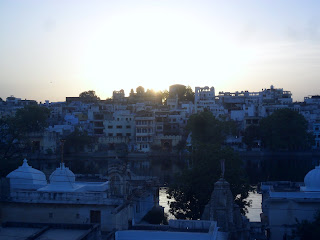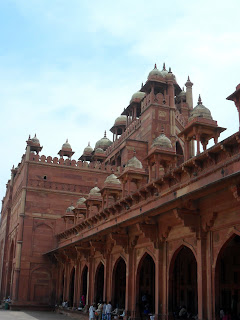Hello everyone!
I really, really like India. I do feel, however, that one or two small issues are preventing me from completely falling in love with this rich, incredible country. Being back in Delhi has reminded me of the frustrations of dealing with rickshaw drivers.
You need to be firm. You need to know when to walk away. But most of all, you need patience. Here are some examples of fares we were quoted during our two days in Delhi, followed by the price we actually paid and how long negotiations took:
· Nizamuddin train station to Bashir’s house: Rs60 but had no idea where we wanted to go, Rs90, Rs200. Paid: Rs75. Time taken: c.15 minutes.
· Old Delhi to Humayun’s Tomb: Rs200, Rs150, Rs120. Paid: Rs110. Time taken: 10 minutes.
· Humayun’s Tomb to Lotus Temple: Rs170. Paid: Rs60. Time taken: 5 minutes.
My favoured bargaining technique is the laugh-in-their-face, followed by the ‘gora price’ (white price) quote, then moving up 10-20 rupees, before walking off but taking one last longing look at the driver whilst stating my price with my fingers. It is an effort, and many would think that haggling for Rs10 is pointless, but it’s the principle. They are trying to drain every last rupee from me, and I cannot let that happen. Rs10 is sometimes two cups of chai!
Even once the price is agrees the game is not over. Some will want to take you to a shop; others will moan and wail and (possibly) curse. But the favourite trick is to say they have ‘no change’. A cycle-rickshaw driver – who was probably more deserving than most, pedalling us around in the oppressive heat – tried this trick on us when he dropped us at the cricket ground. Luckily, cricket games are a big deal here, meaning army soldiers are dotted around. Walking up to one of them and explaining the situation made our cyclist find his change very quickly.
We were at the cricket ground to see an Indian Premier League (IPL) match. The IPL is the second highest-paid sports league, based on first-team salaries on a pro rata basis, second only to the NBA. It is estimated that the average salary of an IPL player over a year would be $3.84 million. It is quite simply monstrous. You would think that a place may be exhausted of a sport after hosting – let alone winning – its World Cup, but the relationship between India and cricket is stronger than the Hulk on steroids. As a result, it is quite difficult to get a ticket to enter the 48,000-seater home of the Delhi Daredevils, but the soldiers don’t seem to pay attention to the ticket touts, and we were soon inside.
Well, we thought we would be. Frustration reigning supreme once again. We were initially turned away because I had a bag, and only girls are allowed to take bags inside. I left it behind the counter in a petrol station and we returned. We were then told that coins and bottles could not be taken into the ground. The suncream, hand gel, mosquito spray et al are put into my bag – and a Rs10 tip into the hand of the man looking after it – and we returned to finally enter the Firoz Shah Kotla Stadium. Until they found our cameras.
There is a list stating that 39 – thirty-nine – different types of item that cannot enter the stadium. These range from pens to coins to flags to…cameras. Now we had a problem. We couldn’t risk leaving something of actual value at the petrol station, but they had meticulously checked Kristina’s bag once, and were sure to do so again. In spite of my pleading with security, they told me there was no locker in the ground where we could leave them, and my attempt of telling them that it would make the IPL popular in Austria fell on deaf ears. One then quietly said to try a different gate. Our bag is checked, and nothing on the big list is found. Challo!
The lengths they went to prevent us taking our cameras seemed perverse when we reached the top tier to find several people videoing the event on their phones. I started using my iPod and aroused no suspicion. The atmosphere, though not as glorious as at the World Cup matches, was vibrant and colourful, even though spectators seemed to cheer everything, rather than just cheer Delhi’s positive moments.
This may be because the IPL is only four years old – meaning that the bond between club and fan isn’t yet tight – and because most fans seem to identify with the favourite people, as opposed to the local team. Many, for example, support Mumbai, because Sachin ‘God’ Tendulkar plays for them. Most IPL teams are also owned by Bollywood stars, so a person who loves Preity Zinta would be more inclined to support Kings XI Punjab than their own city’s team.
Of course, they may have been cheering both sides because Delhi were well and truly rubbish and gave us very little to shout about. I did thoroughly enjoy it – county cricket in England could never be this glamorous or popular – and Kristina…well, I think she enjoyed it once it had started and I could explain the rules. Everybody in the stadium loved it, though I’m sure some bought tickets just to stare at the American cheerleaders imported in for the tournament.
This was the two days we had set aside to see the major sights of Delhi. The Red Fort, known as Lal Qila (a curry house I used to eat at in Manchester), was compact and appealing, seeming more like residential grounds than a defensive barrier. In fact the only time it has a military edge to it was when a man with a large gun came over to tell us to stop trespassing in areas we weren’t supposed to frequent.
We also saw Hanyuman’s Tomb, which is a beautiful building with unerring similarities to the Taj Mahal.
Finally, there was the spectacular Lotus Temple, which is surprisingly plain on the inside. I think it’s because a person of any faith can worship here, so they don’t want to offend anyone.
We once again stayed in the wonderful company of Bashir and his associates. We even had the pleasure of visiting his own house for breakfast. Just the seven pieces of toast were forced down me, but I was happy to eat as he recalled selling goods to Carrie Fisher (Princess Leia in the original Star Wars) and not having a clue who she was, before then being invited for tea with her in Beverly Hills. As ever, dinner was enormous, in both quantity and the level of satisfaction.
It was a busy, gruelling, yet entertaining two days. Kristina has now unfortunately had to return to Vienna, so I am once again flying solo. My volunteering placement starts on Monday, so I have a few days to try to experience something new and incredible. What’s that? Go try and find an endangered tiger? Oh, go on then!
Love you all
Matt








































